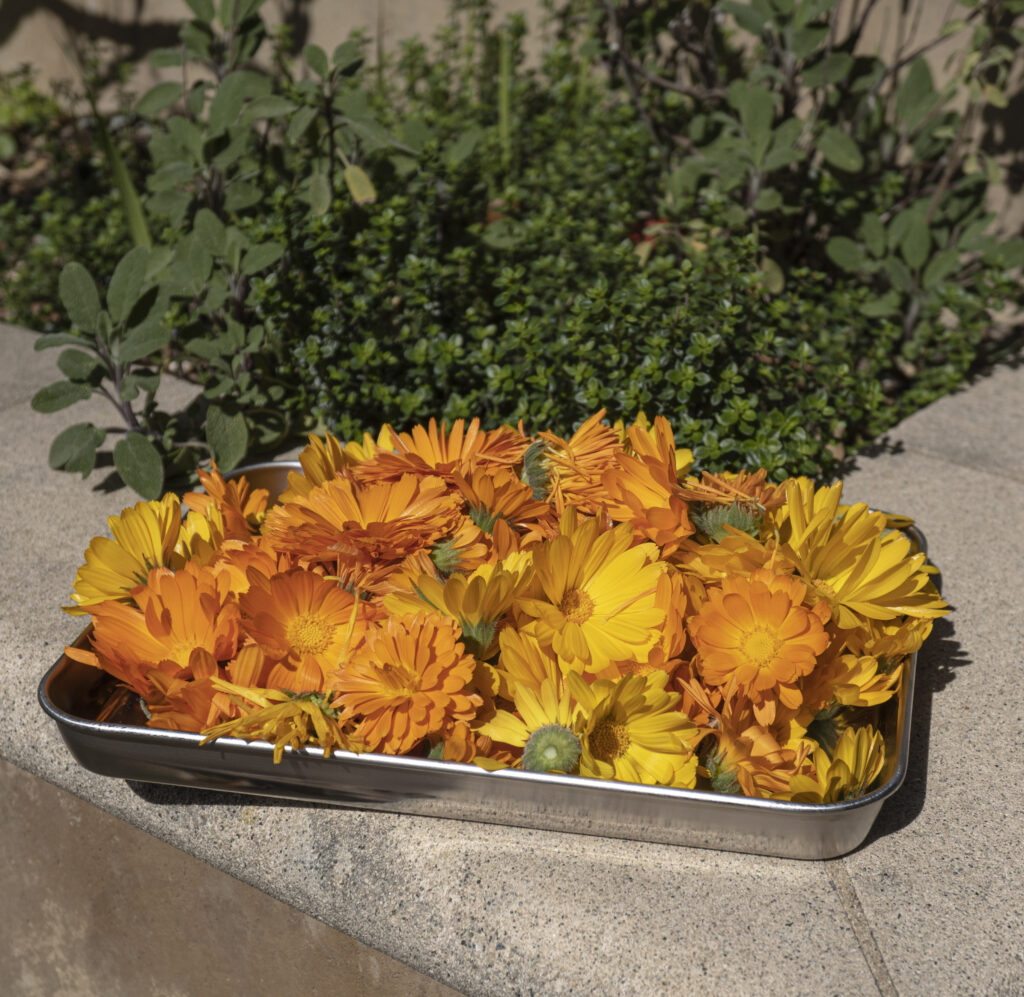Calendula flowers are the principal ingredient in the herbal skin care products we make for the Staccarto shop. We grow most of the flowers in the organic garden connected to the Staccarto Studio headquarters in Sacramento, California. Planting calendula seeds is easy to do and produces beautiful blooms throughout the year. So we want to share a little bit of information about growing calendula in your yard or farm.
First, I wanted to introduce myself, the writer of this blog post. I’m Chloe, the daughter of Staccarto’s founder Kathy Russick. I am Staccarto’s social media coordinator and also an avid gardener. Originally, I wrote a similar article about growing Calendula for my own blog: Floralibra.art.blog. I also grow a portion of Staccarto’s calendula flowers used in my own organic garden in Argentina. The making of the salve is a bit complex and my mom has perfected her recipe over the years. Growing calendula flowers is easy so I’m sharing an adapted version of my original article here on the Staccarto blog.

Beginner herbalists and gardeners beginning their herbal garden find no better plant than Calendula officinalis. This flower is adored by bees & butterflies, has many medicinal properties. It is also a useful pest deterrent to plant alongside tomatoes and other crops. Calendula is an easy to grow herb that I have been growing in gardens for years. So here are my suggestions for planting calendula seeds, transplanting the seedlings and then using this useful herb.
Sew seed in a pot first:

For a healthy and thriving calendula plant, first planting calendula seeds in a small pot and then transplanting into the garden is key. These are cold hardy plants that can be grewn during spring, summer, and fall though they do best when planted in humid & warm months. Calendula needs plenty of water, which is easiest to provide if the young plants are all in one easy to water location. When the plants have several healthy leaves, they are ready to transplant into their permanent location.
Transplant to the garden bed:

As mentioned previously, calendula need humid conditions to get established and the herb has aromatic properties that help deter pests. For both of these reasons I recommend planting calendula alongside tomatoes, kale, and other plants that are prone to insect infestation. Calendula plants need as much water as other vegetables, so planting in a well watered garden will ensure an abundant harvest of these prized calendula flowers.
Collecting and drying calendula flowers:
Begin by collecting the flowers close to mid-day when the blooms are completely open, then, dry the flowers flat on either mesh or cardboard in a warm and well ventilated area that is protected from the elements. This could be on a shelf inside the home or in a garden shed as long as it doesn’t get too hot.

After 5 to 7 days the flowers should be dry. You will be able to test their dryness by touch. Store the dried flowers in a brown paper bag labeled “Calendula Flowers” and the month & year. Or instead of storing, you can use them right away. Calendula has many medicinal properties and can help with menstrual cramps and stomach pain as a tea. But my favorite way to use calendula is as an herbal oil.
Making herbal oil with calendula:

Herbal oils are simple to make and have many applications in day to day life. An herbal oil is a base oil, like olive oil, that has been infused with the medicinal properties of an herb. My favorite method is cold infusion. For calendula, this entails filling a jar half full with dried calendula flowers. Then you pour an oil of your choice into the jar leaving an air gap at the top. You can use olive oil, fractionated (liquid) coconut oil, jojoba oil, or even sunflower oil! Each oil has different properties though all will soothe and moisturize skin especially when infused with calendula.
Once the oil and calendula flowers have been soaking in a dark and cool cupboard for about a month, it is time to separate the flowers from the oil. You can do this by using a strainer and a piece of cloth like muslin or cheese cloth. Once the oil is separated, it is ready to use as a massage oil or facial moisturizer.
You can use this oil on any part of your body, especially skin with sun damage or another form of irritation. Just be sure to start with a small drop rubbed between your hands before applying. Doing overdo it on the oil, you don’t need to use much to receive the healing benefits and too much can stain clothing.
As mentioned at the top of the article, our small family business makes healing skin salves and other natural skin products with Calendula flowers. We’ve been harvesting and planting calendula seeds and have a batch in production which will be hitting the shelves of our online store soon!

